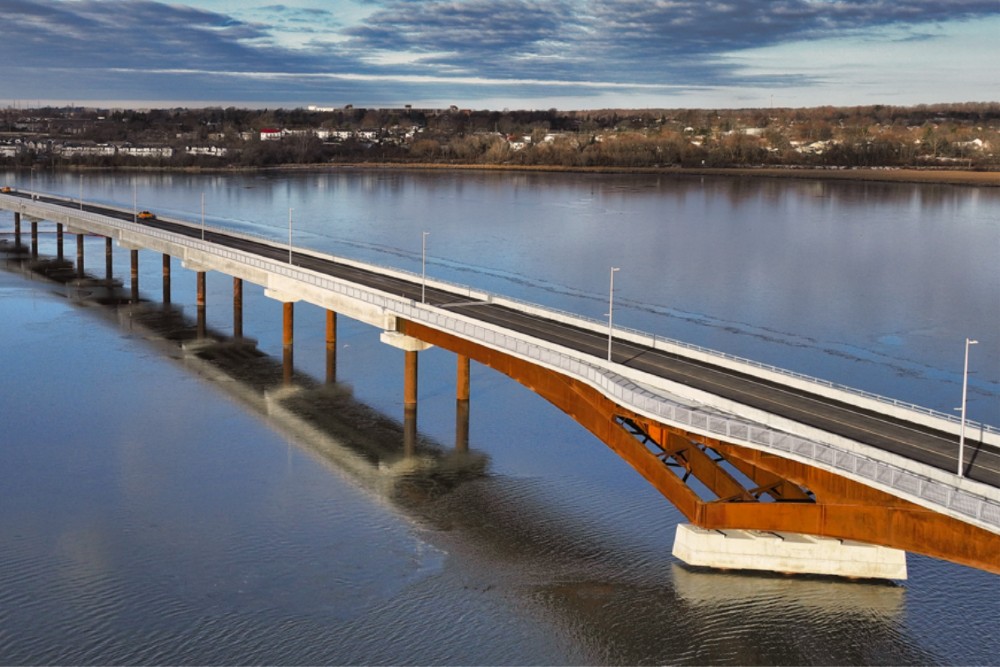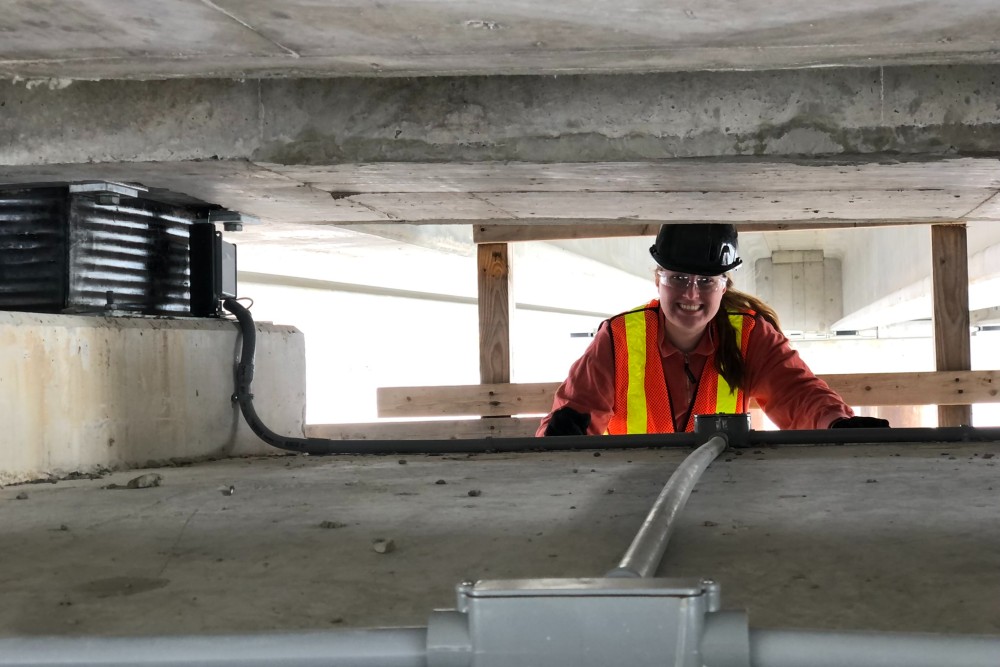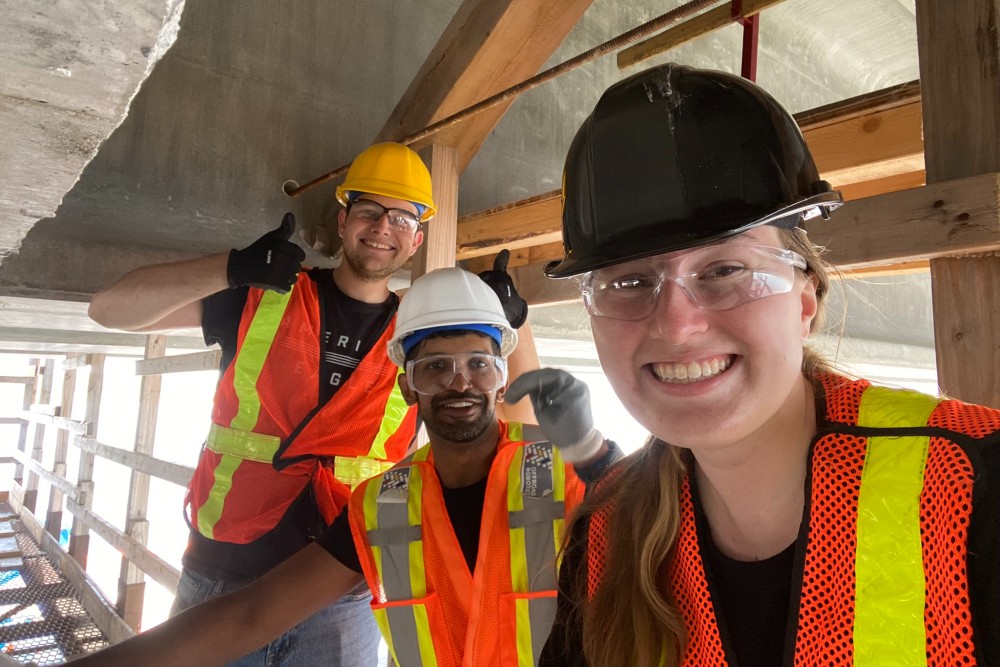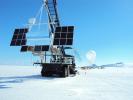BUILDING COMMUNITY TOGETHER
Keeping watch on the new crossing
December 14, 2022
Share

A team of students and faculty members based in Queen’s Ingenuity Labs recently found themselves high above the Cataraqui River looking down at all the construction equipment working on the City of Kingston’s new Waaban Crossing bridge. But they were not on top of the new structure. They were on ladders underneath it, installing sensors on the joints and bearings so the city will be able to monitor how the bridge is working in real time.
The new bridge is the largest infrastructure project the City of Kingston has ever undertaken and opened to traffic on Dec. 13. It is 1.2 km long and took more than four years of construction. All three levels of government each contributed $60 million to the project.
During the construction phase, the city approached Queen’s to partner in finding tools that could help track the performance of the new structure. After more than a year of testing and preparation, the Ingenuity Labs team is now using the latest technology to help the city monitor the safety and integrity of the bridge in an efficient and affordable way.
“One of our goals at Ingenuity Labs is to bring together researchers with different areas of expertise to work on projects that can contribute to the betterment of society. This project gives us a chance to have that impact at the local level,” says Josh Woods, Assistant Professor in the Department of Civil Engineering and the Mitchell Professor in Intelligent Infrastructure Monitoring at Ingenuity Labs. “Without sensor technology, municipalities rely on annual or biannual visual inspections of bridges to determine if there are any issues with the structure. With the sensors that we’ve installed on the bridge, the City of Kingston will have constant access to real-time quantitative data that can help them make more informed decisions about the maintenance of the structure.”

The sensors collect data that examine how the bridge’s expansion joints and bearings perform as the concrete expands and contracts with changes in seasons and temperatures. To ensure the sensors worked properly and could withstand the conditions they’d face under the bridge, the team put them through comprehensive tests in a variety of conditions, including lying them under the sun on top of Ellis Hall and letting them sit in a freezer for extended periods of time.
The Ingenuity Labs team will also be using unmanned aerial vehicles (UAV) – commonly referred to as “drones” – to supplement the data from the sensors with detailed visual inspections. With images captured by the UAVs, the city will be able to inspect aspects of the bridge that would be difficult to see otherwise.
“The City of Kingston is excited to work with faculty and students from Queen’s to find innovative and ‘smart’ methods to monitor the structural health of the new Waaban Crossing," says Mark Van Buren, Deputy Commissioner, Major Projects Office, City of Kingston. "It’s a great benefit for the city to be able to partner with Queen’s and draw on the expertise of the world-class researchers in our own backyard while also giving their students valuable opportunities to develop their skills. We look forward to continue working with the great team in Ingenuity Labs as we maintain this major new piece of infrastructure and keep it safe for our community.”
Students integral to the project
A Queen’s post-doctoral fellow and two Queen’s students are playing instrumental roles in the project: Isabel Heykoop, a graduate student in the Master of Applied Science program; Heshan Fernando, a post-doctoral fellow at Ingenuity Labs; and Dylan Neves, an undergraduate student in the Faculty of Engineering and Applied Science. Each one provided a different perspective and set of skills that contributed to the successful completion of the project.

Heykoop also served as the manager of the project, taking the lead on keeping track of deadlines, submitting plans, and coordinating with the city.
“I went to Queen’s for my undergraduate degree as well, so Kingston has been part of my growth as a student and a person,” says Heykoop. “It means a lot to me to make a contribution to the city that will help improve the lives of people here for years to come.”
Future ingenuity for Kingston
Going forward, the team in Ingenuity Labs is working to provide the city with tools that will help them efficiently analyze the data they receive from the sensors on the bridge. Ingenuity Labs will also be using UAVs to help the city inspect infrastructure beyond the bridge to make decisions about maintenance.
“The City of Kingston gives our students great opportunities to do field work close to campus and use the city as a kind of living lab for them to test ideas and build their skill sets,” says Dr. Woods. “Ingenuity Labs looks forward to continue working with them in the future.”
Learn more on the City of Kingston website and the Ingenuity Labs website.
Impact on the community
This project makes up part of Queen’s social and economic impact on the Kingston community and surrounding area, which has been measured in a study conducted by Deloitte. That study found that Queen’s students, faculty, and staff annually raise more than $1 million to support local causes. It also found that Queen’s students work thousands of volunteer hours for local causes.
Learn more about the community and economic impact of Queen’s students and read the full study on the Queen’s Economic and Community Impact website.
Building Community Together
This story is part of an ongoing series highlighting how students across Queen’s are building community together through meaningful projects in the Kingston area.


![[SNO+ detector at SNOLAB]](/gazette/sites/gazettewww/files/styles/xsjpg1x3to2/public/2024-04/McDonald-Institute-funding-1800x1200-Gazette.jpg?itok=6Lwe0LRj)
